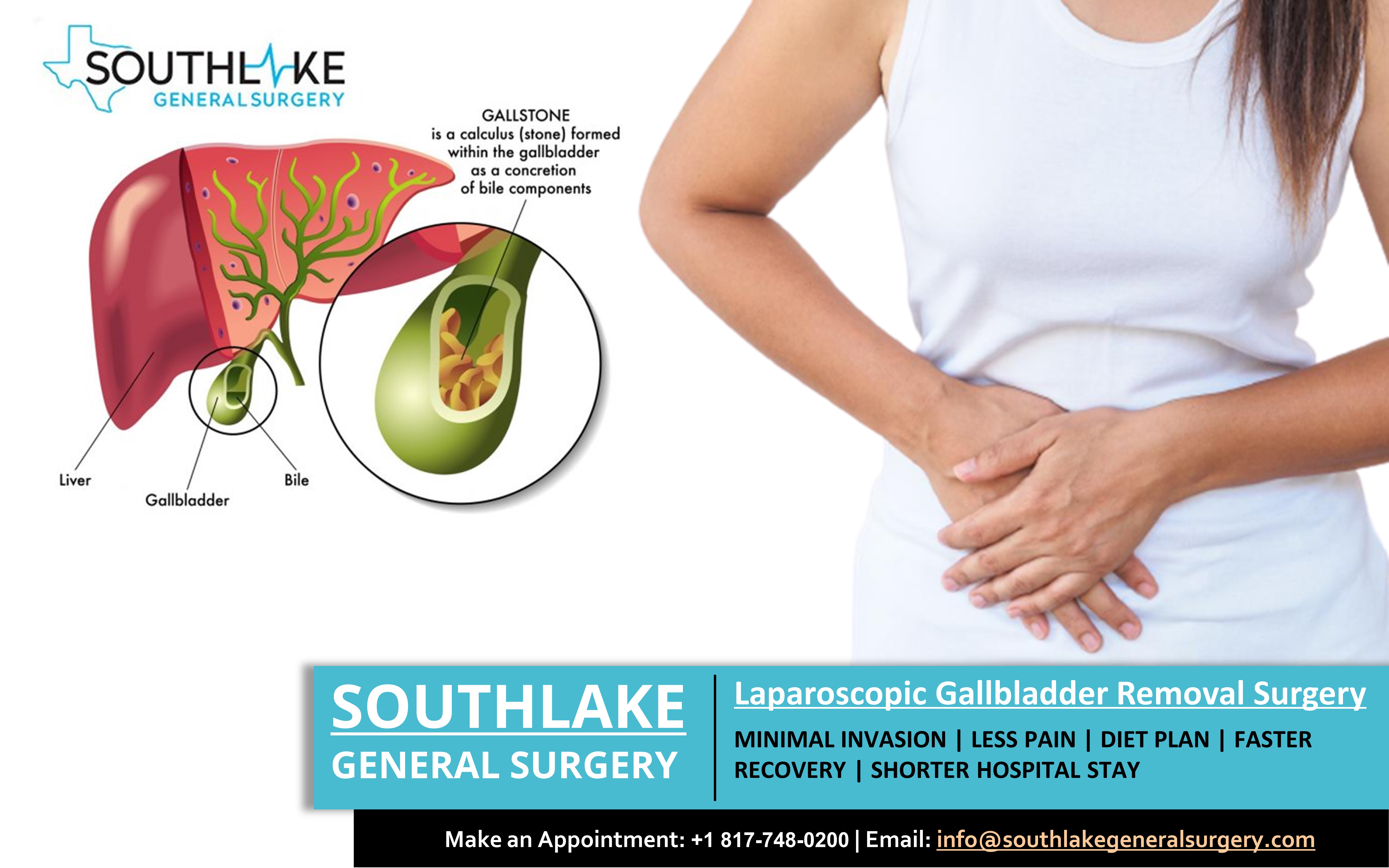Laparoscopic gallbladder removal surgery is also known as minimally invasive surgery, wherein small incisions are made close to the affected area to insert the laparoscope and other specialized surgical tools to remove the gallbladder.
Laparoscopic gallbladder removal surgery at Southlake General Surgery, Texas, is performed by our board-certified general surgeon, Dr. Valeria Simone MD.
The gallbladder is a small, pear-shaped organ located near the liver in the right upper abdomen. The gallbladder stores bile created in the liver and discharges it into the small intestine to help break down and absorb dietary fats.
Life without a gallbladder is not difficult and a person can easily digest food and have normal digestion with some diet adjustments. Gallbladder surgery is recommended if it turns out to be infected and inflamed.
Laparoscopic gallbladder removal surgery is the most common surgical procedure and is also known as laparoscopic cholecystectomy.
What is the reason for performing laparoscopic gallbladder removal surgery?
If an individual is diagnosed with gallstones and their complications, the doctor may recommend having laparoscopic gallbladder surgery. The condition of gallstones in the gallbladder is also known as cholelithiasis. The size of the gallstones can be as small as a sand grain to a golf ball. Few people may develop one single gallstone, while other individuals may have several gallstones.
The doctor may suggest this sort of surgery if you have the following:
- Biliary dyskinesia happens when the gallbladder doesn’t discharge bile properly because of a problem.
- Choledocholithiasis happens when gallstones move to the common bile duct and mainly develop blockage that stops the gallbladder and the rest of the biliary function from draining.
- Cholecystitis is also known as gallbladder inflammation.
- Pancreatitis is a pancreatic inflammation due to gallstones.
Risk factors of a Laparoscopic Gallbladder Removal Surgery
Every surgical procedure has its risks and complications. However, very few surgeries, like laparoscopic gallbladder removal surgery, are considered one of the safest surgeries and have an exceedingly rare risk and complications which include:
- anesthesia or other medicines may cause adverse reaction, such as allergies
- bleeding, infection, or damage to blood veins
- blood clots
- injury or damage to the liver, bile duct, or small intestine
- heart problems like rapid heart rate
- pancreatitis
What should I do before Laparoscopic Gallbladder Removal Surgery?
Your doctor will prescribe various tests before surgery to ensure your health is good enough for the surgical procedure. Tests will include:
- a complete physical examination
- blood tests
- gallbladder imaging tests
- a detailed review of your medical condition and medical history
It is always recommended to discuss with your PCP – your family history of any medical condition, your pregnancy, and any medication you are taking, such as over-the-counter (OTC) drugs or supplements. Your doctor may suggest you stop the medicines before your surgery.
Your doctor will brief you about the surgical procedure, which includes:
- avoid drinking and eating anything for a couple of hours or more before surgery.
- having somebody to remain with you just after the surgical procedure.
- arrangement of the shower with a special antibacterial soap the night prior or the same day of the surgery
- your ride to home.
- arrangement for hospital stays in case of any complications.
How is Laparoscopic Gallbladder Removal Surgery performed?
You will get an IV to inject medication and fluids through your vein. The doctor uses general anesthesia in this surgery and you will be asleep to avoid any pain or discomfort during the procedure.
In laparoscopic gallbladder removal surgery, the laparoscopic surgeon makes 3–4 small incisions close to the affected area to insert the laparoscope, which is a small tube with a mini camera on top to view inside the abdomen and locate the gallbladder. The surgeon inserts the other special surgical tools through the incisions. Your stomach is inflated with gas to make space and help the surgeon remove the gallbladder.
The surgeon removes the gallbladder, and they check the bile duct through a special X-ray for any other problems or abnormalities, such as bile stones, that the surgeon is required to remove. This procedure is known as an intraoperative cholangiography.
Once the surgeon is convinced of the outcome, the incisions will be closed with sutures and covered with a bandage. After completion of the surgery, your health will be monitored, and the doctor will examine your overall health condition prior to discharge.
Many individuals may return home the same day after the laparoscopic gallbladder removal surgery.
Complications after gallbladder surgery and recovery time
The side effects identified with eating after the gallbladder removal surgery are gentle and rare; however, you may encounter diarrhea.
You can resume regular activities after two weeks from the surgery, but it will be under the doctor’s instruction and advice. A complete recovery would take about a few weeks.
After gallbladder removal surgery, your doctor will guide you on how to care for your incision wounds at home during your recovery time. It is always recommended to follow your doctor’s instructions for a speedy recovery and to avoid any infection or injury that may occur after surgery.
Appointment
For more information on Laparoscopic gallbladder removal surgery and consultation with Dr. Valeria Simone MD. Please contact our healthcare expert at +1 (817) 748-0200 or Make an Online Appointment with us.

